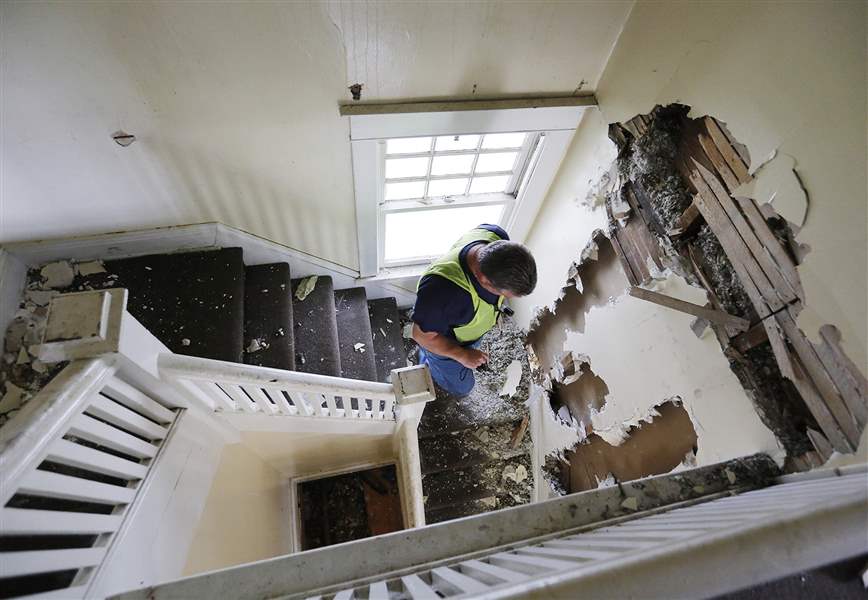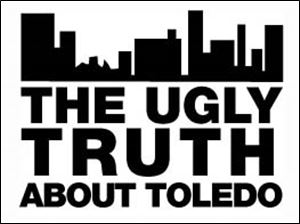
BLADE SPECIAL REPORT: THE UGLY TRUTH ABOUT TOLEDO
Blight blame game heats up between city, housing court
6/22/2014
Scott Ferris of the Lucas County Land Bank inspects 2806 Fulton St. Once a dream property with a fireplace, three bedrooms, and hardwood floors, the house has been stripped and smells of water damage and urine.
THE BLADE/DAVE ZAPOTOSKY
Buy This Image

Scott Ferris of the Lucas County Land Bank inspects 2806 Fulton St. Once a dream property with a fireplace, three bedrooms, and hardwood floors, the house has been stripped and smells of water damage and urine.
The century-old home at the corner of Fulton Street and Kenilworth Avenue at one time was a Realtor’s delight — with a fireplace, three bedrooms, and hardwood floors.
Now, it’s a dump — one of the thousands of uninhabitable, vacant houses scattered throughout Toledo but heavily clustered in poorer city neighborhoods.
Homes such as the one at 2806 Fulton St. — one the Lucas County Land Bank ultimately could acquire — are now in the middle of a political finger-pointing clash between Toledo’s mayor and the city’s longtime municipal housing court judge.
A Blade special report last week highlighted blighted, vacant, and nuisance properties in a series titled The Ugly Truth About Toledo. The aftermath pitted the two elected officials against each other in a blame game, and it pulled the land bank into a community discussion on dealing with the city’s burgeoning blight problem.

RELATED: Check out the Ugly Truth Toledo page
Mayor D. Michael Collins, who campaigned last year on making neighborhoods better, blamed a logjam of housing cases in Toledo Municipal Court. He released numbers to prove his claim that the court was impeding the demolition or otherwise addressing dilapidated homes.
“The city’s ability to act when it comes to nuisance properties is often times delayed or prevented by the Toledo Municipal Court,” Mayor Collins said. “These cases are under the control of the housing court, which is adjudicated by Judge C. Allen McConnell. Cases have lingered for years with the city unable to force demolition.”
Mayor Collins said more than 500 affidavits were filed in Toledo Municipal Court by the city’s code enforcement department during the last 12 months — which stretches back into the final six month of Mayor Mike Bell’s term.
PHOTO GALLERY: Click here for more photos
Mayor Collins also blasted the housing court for its total number of active cases: 1,576. Nineteen are the oldest, dating to 2000.
Judge McConnell said laying blame for the city’s housing problem on his bench is unfair and that it’s the city that has the authority to raze homes, not his court.
“For the housing docket, beginning in May, we started with 352 cases, and at the end of the month we had winnowed it down to 228 cases that we have active,” he said.
The caseload
A review of court records showed that in May, 88 new cases were filed. Those cases included house-stripping, zoning violations, and environmental-code violations. By the end of the month, 124 cases were closed in the housing court. Of the 228 cases pending at the end of May, 23 were older than six months.
Judge McConnell said cases drag on for a variety of reasons, including delays in the homeowner’s efforts to bring the property into compliance or perhaps the owner cannot be located or is on the lam. In that case, he issues a bench warrant, and it’s up to police to bring the person back.
Of the 1,576 cases dating to 2000, the judge issued bench warrants for 1,322, court records show.
“You can have a number of cases out there that the owner refuses to come to court, but once they show up, it is activated and put back in the system,” he said.
Judge McConnell said he doesn’t hesitate to get tough with property owners but stressed that the city has the authority to raze homes.
“If the property is not vacant, and they are living in the property, cleanup is the priority, and I will have them back in two weeks to make sure it’s clean and secure,” he said. “If it’s vacant, I want it boarded and secured ... and if the homeowner is unable to do it, I can order the [city] to do it or some other program to secure it.”
Homeowners can voluntarily sign a “disclosure and release” form, giving the city authority to tear down a home. Most tell the court they want the city to “take the home,” but that’s not what the city does. Judge McConnell said 150 property owners signed the form and still are waiting for demolition, which will ultimately be billed to the homeowner.
“If the current list for demolition by the city is approximately 600, I can only assume that the other 450 houses were put on the list by the director of code enforcement pursuant to his power under the Toledo municipal code,” he said. “Either the city or the land banking program will eventually demolish it, but it could be sitting on that demolition list for months or years.”
Losing the war
The fight against blight is being lost, the judge concluded.
“I thought we were far ahead of the game one to three years ago, but now it has spiraled out of control,” he said. “I wish the city had not given up the demolition program because in the past, if a homeowner said a property was in such bad shape, we could get it demolished immediately.”
The city’s director of inspection, Chris Zervos, declined to be interviewed.
City spokesman Lisa Ward said Mayor Collins wouldn’t back down from his criticism of the court.
“The discrepancies in the numbers demonstrate that there is a miscommunication that needs to be investigated,” she said. “The mayor is going to continue to move forward his plan for a [new smart-phone and Web application] for people to report things like blight, high grass, nuisance, graffiti, and also continue putting community service officers and code inspectors out on the streets to report blight and other issues.”
Land bank
Before the Lucas County Land Bank took over demolitions, the city of Toledo razed an average of 300 homes annually. Now, the city has no budget for home demolition. Although city employees still do the actual demolition, it’s paid for by the land bank, said Wade Kapszukiewicz, Lucas County treasurer and chairman of the land bank’s board of directors.
Last month, the land bank tore down its 838th structure at a cost of nearly $6.8 million since August, 2012. Half of the money came from the Ohio Attorney General’s Office while the other half came from money generated by the land bank. A second phase of demolitions will take down another 600 homes using a $6 million grant from the Ohio Housing Finance Agency, an independent state agency formerly part of the Ohio Department of Development.
The land bank, also known as the Lucas County Land Reutilization Corp., was created in August, 2010. It typically acquires houses to demolish them or, when possible, converts them to other uses or resells them. It also has a fund that helps bridge financing gaps for development projects.
“We have the ability to acquire any vacant, abandoned tax-foreclosed property we want,” Mr. Kapszukiewicz said. “Previously it would take five or six years for a property to go through a tax sheriff bid, but now we can acquire it in six months.”
The land bank has just seven employees, including one field technician who inspects homes the land bank will consider acquiring.
The condition of 2806 Fulton, a forfeited property, is common for an abandoned home, the land bank official said. The pipes were stripped out, leaving huge holes in the walls; the furnace and duct work are gone, and the place smelled of water damage and animal urine.
“This is the aftermath of someone coming in to strip out a property, and it can happen at times within hours after a property is abandoned,” said David Mann, land bank president.
Although its reputation as a demolition agency for abandoned homes is growing, part of the land bank’s function is to have homes rehabilitated, he said.
“The land bank is one tool; it’s not a panacea,” Mr. Mann said. “We are a catalyst in the true sense and we are trying to get control of properties that are causing blight.”
The land bank doesn’t acquire homes or vacant land without an “end user in sight,” he said. That is, the agency wants a new owner lined up beforehand. In the case of a vacant lot, it is sold for $100 to adjacent homeowners often to use as a side lot or garden.
The land bank has so far transferred 639 vacant lots and 185 homes to new owners to renovate. Three out of those 185 homes “have not worked out,” Mr. Mann said. “The other 182 are functioning homes that would have otherwise be blight right now.”
Contact Ignazio Messina at: imessina@theblade.com or 419-724-6171 or on Twitter @IgnazioMessina.